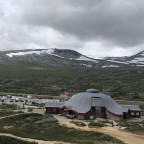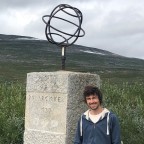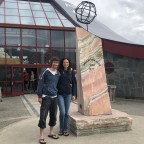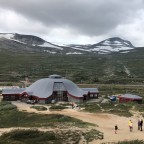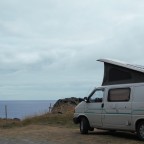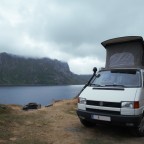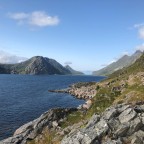How to get to the Lofoten
02.08.2019-03.08.2019 - On Friday afternoon we decide to set off towards the Lofoten. The main road E6 is full of construction sites (according to signs until 2021) and it partly reminds us of poor country roads in Austria. We drive until we get tired and spend the night offside the road at a rest area with some other campers.
The following day at breakfast we calculate the drive times and ferry costs of various routes. We finally decide to take the ferry from Bodø to Moskenes on the Lofoten. Before we get on the ferry, we stock up all supplies and water. Refueling turns out to be more challenging than expected since we do not immediately find a cheap gas station.
At the arctic circle in Norway
The arctic circle is located at a northern latitude of 66.5 degrees about 80 kilometers north of the town Mo i Rana in Nordland. It runs through a barren mountain range called Saltfjellet. North of this line the sun does not set in summer. The sign for this imaginary line could be missed easily, but there is a huge center visited by many tourists. Of course we stop and take some pictures once we are there. The cold wind encourages us to switch from shorts and flip flops to long trousers, socks and sturdy shoes.
Cold wind and snow as a welcome
During the crossing a cold wind blows around our noses. The closer we get to the Lofoten the better we can see the snow on some of the mountains and in the gullies between them. Now we probably have to pack away the short T-shirts and take out the long merino underpants.
Overnight stay: N 67.9619, E 13.1520 (Parking near the tunnel)
First freezing, then sweating
04.08.2019-05.08.2019 - Of course the printer is bitching when you need it. Therefore, we set off to the parking near the climbing area quite late after solving the printer problems and warming up. We meet two Finnish climbers who want to tackle the same route. We consult with them about the proper gear. They plan to climb with two complete sets of camming devices and nuts, but with a single rope and a Beal Escaper sling. We strongly advise them not to use the single rope since the descent may include one or more sections of rappelling. We joke about rescuing them in case of an emergency and that they could provide us with first aid since they are doctors. The two of them still want to debate which rope to use and make themselves something to eat. Therefore, we set off first. This has pros and cons. On the one hand there is nobody above us kicking off loose stones and we do not have to wait. But on the other hand we have to find the line and they can climb comfortably behind us.
Cold wind instead of light breeze
The Sea Breeze (N5, UK: HVS 4c, 8 pitches, Top 50) is a multi-pitch trad route which is apparently hard to protect due to its slab climbing (marked with a fluttery heart symbol). Along the climb we have a fantastic sea view, but on this day there is no light sea breeze but a cold wind. One of the Finns claims that this climb is some sort of meditation for him. My teeth are chattering and I can hardly feel my fingers while climbing. The long climbing pants and the wind-stopper jacket over the long-sleeved climbing shirt are certainly not enough. I gaze longingly at the down jackets of the Finns. Fortunately, we are fast although it is our first trad route in several years and Sigi needs a little longer to place the protections and find the line. He climbs confidently and hardly places protections. The distance between them is oft well over 10 meters. However, he takes absolutely no risk at the belays and protects them with multiple gear in order to prevent a fall of the rope team.
Full of joy we arrive at the top. At this point we do not know that the climb was easy compared to the descent. We make the mistake of choosing the first descent option via the nearby gully because we find new gear for rappelling on a tree. The gully is heavily overgrown. The rope gets stuck at almost every pitch, no matter how well we place it in advance. Sigi has to do some risky actions to free the rope. The gully is steep, wet and slippery -> we have chosen the wrong one!
We are happy when we arrive back at Elmo. We quickly stow our gear and turn up the heating. A few kilometers down the road we find a resting place with a great view over the sea. We sit in the warm van and enjoy.
The next day welcomes us with bright sunshine. We stay at the resting place throughout the day and plan our stay on the Lofoten. For my taste, the routes nearby are a bit too difficult or too badly rated. Therefore, Sigi and I agree to get up early the next day and to drive on to Henningsvær.
Overnight stay: N 68.0081, E 13.2624
Lessons learned
- At many gas stations you can get free water if you ask the attendant for the key.
- A cold wind can chill you quite quickly even if you are wearing a wind-stopper jacket.
- A climb is not over until after the descent. The descent can turn an easy route to a risky and dangerous one.





